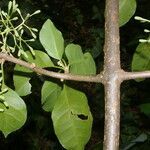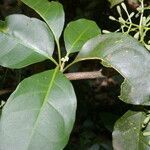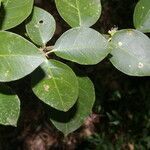Divaricately branched shrub or woody liana, usually armed with stout recurved axillary spines, glabrous to densely pubescent. Leaves opposite to irregularly approximate, the blade very variable in shape and size, usually obovate to obovate-elliptic, acute to acuminate, 2-10 cm. long, 1-5 cm. broad, the petiole 1-3 cm. long. Inflorescences usually borne at the tips of greatly condensed short shoots, umbelliform or densely corymbiform-thyrsiform, rather shortly pedunculate, 3-6 cm. long, greatly accrescent and expanded in fruit, many-flowered. Staminate flowers campanulate, greenish yellow, about 3 mm. long, about 2 mm. in diameter at the orifice of the limb, minutely puberulent-papillate without, the stamens widely exserted. Pistillate flowers tubular to somewhat urceolate, about 2.5 mm. long and 1 mm. in diameter, the limb erect, the stigma and style widely exserted. Anthocarps borne upon greatly elongate pedicels, pentagonal-clavate, 7-9 mm. long, 3-4 mm. broad, green, coriaceous, the stipitate glands uniseriate upon the five angles, the sides minutely and densely puberulent.
Overhanging climber to 20 m high, with mostly recurved, axillary thorns 0.5-1 cm long (abortive shoots). Leaves (sub)opposite, elliptic, 4-10 by 1.25-5 cm, base acute, top obtuse, puberulous or glabrous; petiole 0.5-2.5 cm. Flowers unisexual in dense, cymose, axillary inflorescences, brown short-hairy, 1-2½ cm ø. Peduncle 1.5-3 cm. Bracteoles 1-3, oblong at the base of the receptacle to halfway on the pedicel; pedicel 1-1.5 mm. Female flower campanulate, urceolate, 2 by 1.25 mm, androecium completely abortive. Male flower funnel-shaped, 3 mm ø; stamens 8, exserted for 0.5-1 mm. Limb with 5 larger lobes (only in the male flower recurved) which alternate with 5 smaller ones; opposite the latter 5 rows of black stalked glands on the outside of the perianth. Stigma fimbriate, 1-1¼ mm exserted. Anthocarp club-shaped, 15 by 2-2¼ mm, puberulous, with 5 ribs each bearing a biserial row of glandular appendages which grow out to soft viscid prickles c. 1.5 mm long; pedicel 2-2½ cm. Seed 9-11 by 2-2.5 mm.
Dioecious scandent shrub or climber to 20 m long, glabrous, puberulous or tomentose; stems with spreading, opposite and decussate branches, bearing axillary thorns; thorns 5–10 mm long, usually recurved. Leaves petiolate, opposite or nearly so; lamina elliptic, ovate or broadly ovate, to 12 cm long, to 7 cm wide; petiole to 2.5 cm long. Inflorescences dense axillary cymes which expand in fruit; peduncles 1.5–3 cm long; flowers cream or yellow, scented. Male flowers funnel-shaped, 5-lobed, c. 3 mm long; stamens 6–8, exserted; gynoecium vestigial. Female flowers campanulate or urceolate, 5-lobed, c. 2 mm long; androecium vestigial; stigma fimbriate, exserted. Fruit clavate, 1–2 cm long, 2–3 (–4) mm wide, ribbed; ribs with double row of glands which develop into soft viscid, prickle-like glandular hairs c. 0.5 mm long. See also Cooper & Copper (2004), Zich et al. (2020).
Shrubs vinelike, climbing, to 20 m. Bark olive green. Stems with axillary spines, pilose or glabrous; branches pendent, often with 5-10 mm, recurved thorns. Petiole 1-1.5 cm; leaf blade ovate to elliptic, 3-10 × 1.5-5(-7) cm, ± leathery, abaxially greenish, adaxially dark green, glabrous, pubescent yellow-brown, lateral veins 4-6 pairs, base cuneate or rotund, apex acute or obtuse. Cymes axillary, yellow-brown pubescent. Pedicel with 3 ovate bracteoles near apex. Flowers unisexual; perianth yellow, fragrant. Male perianth tube funnelform, puberulous, apex 5-lobed, lobes short triangular. Stamens 6-8, exserted; anthers subglobose. Female perianth tube ovate-tubular, apex 5-lobed; style exserted; stigma lacerate. Fruit clavate, 7-14 × 4 mm, 5-ribbed, with rows of stalked glands and brownish black pubescent; carpopodium long. Fl. Jan-Jun.
Vines or shrubs, to 3 m; vines subscandent, woody; branches spreading at right angles, armed with stout, recurved spines 6-20 mm. Stems velvety when young, glabrate later. Leaf blades ovate to obovate, 2-10 × 2-7 cm, base cuneate, apex subacute, glabrate. Inflorescences: staminate inflorescences subglobose, dense, 1-3 cm diam.; pistillate inflorescences subglobose at anthesis, more open in age; branches divaricate or ascending; fruiting pedicel 0.5-2 cm. Perianths: perianth of staminate flowers yellowish green, broadly campanulate, 2-3 mm, densely and shortly viscid-villous; perianth of pistillate flowers greenish, often blushed with red, 2-3 mm, puberulent. Fruits clavate, 7-10 × 3-4 mm, densely puberulent between glandular ribs, glands extending entire length of fruits.
Dioecious climber to 20 m. with paired axillary recurved thorns, 5–10 mm. long.. Leaves opposite or subopposite, elliptic, ovate or broadly ovate, to 10 cm. long, 7 cm. wide; petiole to 2.5 cm. long.. Inflorescences dense axillary cymes, expanding in fruit; peduncles 1.5–3 cm. long; flowers cream to yellow, scented.. Male flowers funnel-shaped, 5-lobed, ± 3 mm. long; stamens 6–8.. Female flowers campanulate to urceolate, 5-lobed, ± 2 mm. long; stigma fimbriate, exserted.. Anthocarps clavate, 8–27 mm. long, 2–2.5 mm. wide, ribbed; ribs with soft viscid, prickle-like glandular hairs.. Fig. 5.
Female flowers: 2–2.5 × 1.3–1.5 mm., perianth tubular to urceolate, 5 larger lobes alternating with 5 smaller ones, pubescent, 4–5 longitudinal rows of black glands developing as perianth matures; ovary 1.5–1.7 × 0.5–0.75 mm., elliptic-ovate, glabrous, 1-ovulate; style 0.5–0.8 mm. long, exserted; stigma multifid.
Leaves alternate to subopposite, 1.5–5 × 1–3 cm., elliptic to more or less circular, obtuse-acuminate to rounded at apex, broadly attenuate to more or less rounded at base, glabrous to pubescent (sometimes concentrated along main veins), subcoriaceous; petioles 0.3–2 cm long, pubescent.
Male flowers: perianth 2.5–3 mm. long, infundibuliform, pubescent, 5 larger lobes alternating with 5 smaller teeth, lobes triangular, spreading or recurved; stamens 6–8, exserted, 3.5–6 mm. long; filaments, 3–5.5 mm. long, filiform; anthers 0.5–0.6 mm. diam., orbicular.
Inflorescences axillary, female laxer than male, branches densely pubescent to tomentose; pedicels much elongated in fruit; bracts 2–3(4), attached near base of perianth, 0.3–0.8 × 0.3–0.4 mm, ovate-oblong, pubescent.
Anthocarps 10–25 × 2–4 mm., 4–5-angled, 2–3 longitudinal rows of viscid stipitate glands along each angle, tomentellous to tomentose on flat surfaces between glands.
Stems slender, terete, spreading; younger shoots ferruginous pubescent to tomentose.
Large scandent shrubs, armed with recurved axillary spines (abortive shoots).
Flowers pale yellowish or greenish white, scented.
Local, and possibly introduced.
Scandent shrub, to 30 ft. high
Trunk attaining 150 cm. diam.
Flowers cream.




